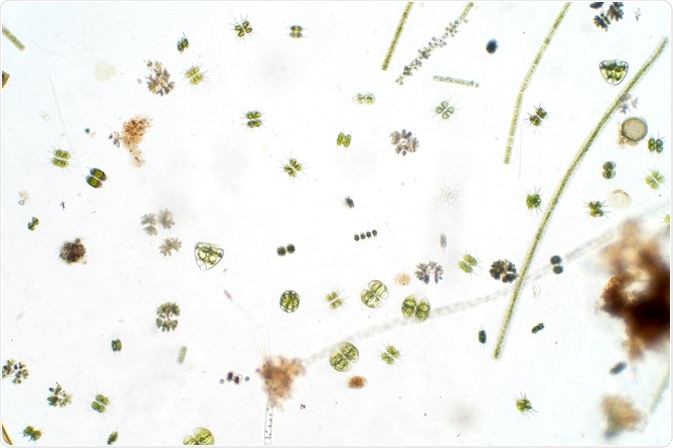In the story of life on Earth, there have been countless species that have come and gone over the course of billions of years. Life evolved from the simplest of single-celled organisms to the multivariate complex biological systems which make up the diversity of the modern world. The choanoflagellates are one chapter of this dynamic story.
 Image Credits: Choksawatdikorn / Shutterstock.com
Image Credits: Choksawatdikorn / Shutterstock.com
The choanoflagellates: an overview
Considered to be amongst the precursors of the animal kingdom and share a common ancestor, the choanoflagellates are free-living, single-celled eukaryotes that can form colonies, occupying a unique evolutionary niche. Choanoflagellates are abundantly found in a wide variety of marine and freshwater environments, soil, and permafrost, and have been identified in ice cores up to 32,000 years old.
Choanoflagellates have a distinct morphology. This is characterized by a spherical/ovoid shape and a single flagellum that is surrounded by around 30-40 microvilli. They are typically between 3 and 10 µm in diameter. The flagellum creates a water current that propels the choanoflagellate through its environment and helps trap its food source, which is bacteria and marine detritus.
There are many species of choanoflagellates. In their communities, they are more abundant compared to other nanoplankton species but the factors that lead to their distribution and dispersion are poorly understood. Clearly, more research is needed to elucidate this.
Characteristics and classification
Choanoflagellates have a constant internal organization with such features as a flagellar basal body at the base of the flagellum, an apical to central nucleus, and food vacuoles in the cytoplasm’s basal region. The cell is surrounded by a periplast.
Historically, choanoflagellates have been classified into three families based upon the morphology of the periplast:
- Codosigidae – Appearing to lack a periplast under light microscopy. Under electron microscopy, a fine outer coating is usually observed.
- Salpinogidae – Members of this family have a firm theca comprised of polysaccharides, primarily cellulose, which is visible under both light and electron microscopy.
- Acanthocediae – Cells in this family produce a siliceous basket-like lorica.
More recently, studies have been performed which have used molecular sequence data to further refine these classifications.
It is unknown just what purpose the periplast serves but there are a few theories. It may help to increase drag in the water in planktonic species, counteracting the flagellums force, whilst in sessile species, it may aid in attachment to substrates. In planktonic species of choanoflagellate, it may also increase feeding efficiency.
As mentioned above, choanoflagellates can be either free-swimming or sessile and are typically heterotrophic. Some relatives of these single-celled organisms such as the Ichthyosporeans follow a lifestyle that can be pathogenic or parasitic.
The choanoflagellate’s life history is poorly understood. What is also not understood properly is the lifecycle: most grow vegetatively, undergoing longitudinal fission and it is unclear if there is a sexual phase to the lifecycle or not. One interesting fact is that some choanoflagellates can undergo encystment upon transfer to fresh media (though this has not been observed directly.) Another interesting facet of these organisms is that colonial species have a solitary stage.
More research on the choanoflagellate lifecycle could help provide more information on coloniality mechanisms and this research can help to understand the unique position of these organisms in the evolutionary record as true forerunners of multicellular life.
Relationship of choanoflagellates to metazoans
The first evidence of the relationship between choanoflagellates and metazoans was provided in 1841 by the French biologist Dujardin, who noticed the morphological similarities between choanoflagellates and sponge choanocytes. Over the past few decades, there has been a growing body of independent research that has upheld the evidence of this close relationship.
Within a phylogenetic framework, the relationships between choanoflagellate families have not been tested properly. By providing complete phylogenetic data on these internally reconstructed relationships ancestral character states can be elucidated, which provides insights into their position as the animal kingdom’s last unicellular ancestors.
There is no fossil record for the choanoflagellates. Their relationship to metazoans has been elucidated from studying species that currently exist.
Within an animal’s genetic toolkit, there are highly conserved genes from select gene families. These code for such cellular functions as intracellular communication, cell adhesion, apoptosis, and tissue differentiation. Some of the gene families have their origins in unicellular organisms such as choanoflagellates.
Specific genes have been identified by researchers so far that provide evidence for the evolutionary link between choanoflagellates and metazoans. These include premetazoan origins of cadherins and integrins, which are cell adhesion molecules, and cell-signaling transduction pathways such as tyrosine kinase.
Recent studies that have provided the evidence of the link between choanoflagellates and metazoans include studies on 185 rDNA, mitochondrial genomes, and nuclear-protein coding genes. More importantly, mitochondrial genome sequence studies on choanoflagellates and 3 species of sponge have provided evidence at the genetic level that choanoflagellates are distinct from, and not descended from, metazoans.
Lastly, there is evidence that choanoflagellates synthesize homologs of metazoan genes that are involved in cell adhesion and signaling. All this data points to the choanoflagellates being distinct from, and related to, metazoans in the evolutionary record.
In conclusion
Because data exists from several independent studies providing evidence of the close relationship between choanoflagellates and metazoans, we can gain insights into the biological makeup of their last common ancestor. These studies are filling in the gaps in our understanding of how life evolved from a unicellular to multicellular stage which is helping scientists to write the story of life on Earth.
Sources
Fairclough, S and King, N. (2006) Choanoflagellates. Choanoflagellida, collared-flagellates The Tree of Life Web Project (Accessed 12th May 2020) https://ucmp.berkeley.edu/protista/choanos.html
King, N. et al. (2008) The genome of the choanoflagellate Monosiga brevicolis and the origin of the metazoans Nature 451(7180) pp. 783-788 (Accessed 12th May 2020) https://www.ncbi.nlm.nih.gov/pmc/articles/PMC2562698/
Richter, D.J and Nitsche, F (2017) Choanoflagellata Handbook of the Protists pp. 1479-1496 (Accessed 12th May 2020) link.springer.com/referenceworkentry/10.1007%2F978-3-319-28149-0_5
Further Reading